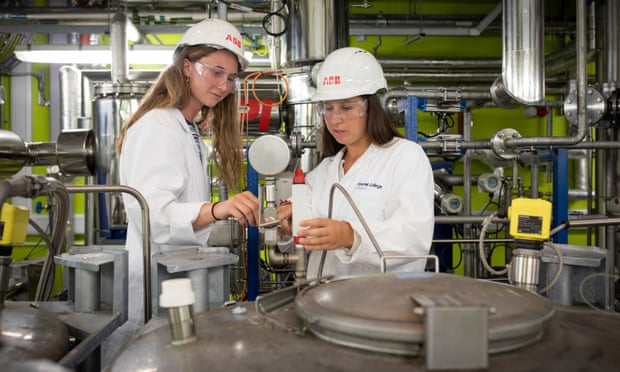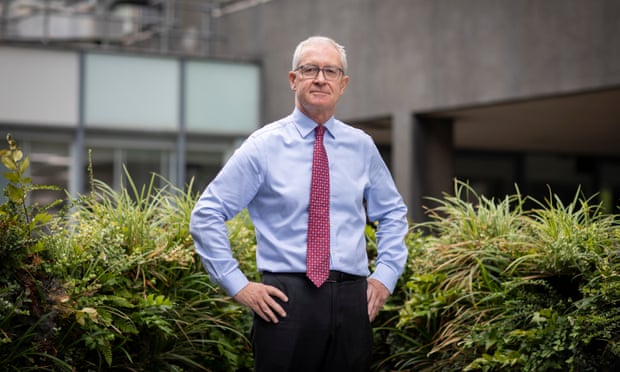Deep inside Imperial’s South Kensington campus, teams of current and former students are tapping away on laptops, running businesses and sharing ideas. There’s a company using sailboats to gather data to chart weather patterns, another providing AI-powered, low-cost tutoring, one with an innovative way to weigh chickens, and another dreaming up ways to hand over more power to retail investors.
This is the university’s enterprise lab, the crown jewel in an institution that prides itself on blending business with the sciences. It’s a major draw for students, with one in eight using the space to brainstorm their fledgling business ideas, attend workshops on entrepreneurial skills, network with other students and receive mentoring from experts and alumni. It’s so successful at what it does, it has an exceptional 79% survival rate for the startups it launches.
The mixture of science and business is what makes Imperial unique, says the university’s new president, Prof Hugh Brady. “Innovation and enterprise are really part of the DNA, they’re part of what attracts the students. The atmosphere is different: impact, innovation, entrepreneurship just ooze out of the institution.”
Science courses typically include business and finance modules, regardless of subject, while students in the business school are drawn to the university’s strength in science. A new multi-disciplinary undergraduate course in economics, finance and data science, launching this year, is generating considerable interest.
Imperial has some of the best-resourced entrepreneurship facilities in the country, including the largest mentoring system – based on the MIT model – and biggest prize fund for its lead entrepreneurial competition, the venture catalyst challenge.
Also part of this picture is the Enterprise Lab, and the companion Hack Space, where students can access equipment, such as 3D printers, to build prototypes for their ideas.
Yet Imperial has ambitious plans to grow all of this further. To help make it happen, the university has just received a Stanford-inspired founders pledge from seven alumni founders to donate a portion of their future revenue to the college to benefit budding entrepreneurs.

According to the vice-provost for research and enterprise, Prof Mary Ryan, this matters because it’s what students – and employers recruiting them after they graduate – expect from an Imperial degree.
“There’s a recognition that [for] our student body in particular, and [for] all students of this generation, there’s a hunger to explore entrepreneurship and ways they could develop their own ideas while they’re studying,” she says.
She adds that “not just what can we learn, but what can we do with what we learn” is an ethos that is integral to the institution, with working with industry cited in its founding charter, which dates to 1887, when it was created alongside South Kensington’s world-class museums as part of Prince Albert’s vision for an area of culture.
This is underpinned by the university’s strength in research, something that came to the fore during the pandemic, as its multi-disciplinary Covid response team shaped how governments around the world responded to the crisis.
This has translated into an applications boost for the university, with lots of students citing the team in their applications, says the vice-provost for education and student experience, Prof Emma McCoy. “We’ve been seeing an increase in our application numbers over the last decade, and year-on-year. It’ll be interesting to see what happens over the next couple of years.”

This culture is reflected in a highly research-intensive curriculum, where students are taught by leaders in their field and are expected to generate their own knowledge. Imperial prioritises a multi-disciplinary approach, including obligatory modules in disciplines outside their undergraduate degree.
The university has enjoyed a steady rise up the rankings in recent years, rising from 9th place in 2021 to break into the top five for 2023 – something it has only done twice before since the Guardian rankings began. Graduate prospects have long been an area of strength for the university – 94.5% of the most recent cohort found their way into a graduate-level occupation within 15 months. The university ranks highest in the guide for employability, thanks to its subject mix, entrepreneurship focus and industry placements. McCoy says producing work-ready graduates is a priority, with employers appreciating how they “can hit the ground running”.
The university’s rise up the rankings has been partly buoyed by an improvement in its National Student Survey results. This is the result of a five-year drive to improve the student experience, which has seen Imperial involve students more closely in shaping their education and learning environment, building an inclusive scholarly community and boosting its bursary scheme.
“It’s always a challenge at a research-intensive [university] because our courses are especially challenging, which attracts the students as well,” McCoy acknowledges.

Part of its attractiveness, Brady suggests, is that there is no “direct competitor” to the institution. However, he says that elements of its White City campus, which combines high-tech facilities aimed at creating the products and services of the future with community outreach, remind him of Kendall Square in Boston – which neighbours MIT – or the Stanford-Berkeley axis in California.
“When I was in the States, [in the] 1980s and 90s, the Ivy League almost woke up one day and said ‘gosh, what happened, there’s this new kid on the block, Stanford’, which has some similar characteristics to Imperial. I think we’re at that transformation [point] where students are now coming to Imperial because it is different, because they know they’ll get a high-quality education that’s infused with the latest research and discoveries, but with an eye on impact and innovation,” he says.
Despite its popularity, there is an existential threat facing Imperial: the real-terms decline of the value of the tuition fee, which is now worth a third less than when it was increased in 2012. Brady estimates that the shortfall for Imperial’s courses, which are expensive to run, averages around £4,000, a hole the university plugs through “incredibly generous donors”, lucrative industry partnerships and using the higher fees paid by international students to cross-subsidise courses.
“The funding model doesn’t cover the costs of educating UK students, and that has to be addressed,” says Brady, adding that he and other university leaders are pressuring government to prioritise increasing state funding or raising tuition fees, or combining the two. “If there’s a critical decision for the country over the next two or three years, it is what is that funding model, and how do we build it so it’s sustainable and aligned with the Stem needs of the economy.”

This challenge is compounded by the fact that, as an international institution, Imperial is competing against US universities, which benefit from a longstanding culture of alumni endowments and philanthropy, and emerging Asian institutions, which receive far more state support.
Yet overall, Brady feels that, culturally, Imperial is in a strong position at the moment. “There’s a much wider and deeper appreciation among society of the value of science, engineering and medicine to humanity and the planet,” he says, adding, “you have government economic policy, which absolutely has Stem, innovation, entrepreneurship and digital skills central to it, and you have a skills pipeline that needs more engineers.
“You can really argue that Imperial has never been more important to the country.”
Brady took the reins in August, and his first plan is to meet as many staff and students as possible, to understand what they’re proud of and what needs to change – including an ongoing project to re-evaluate Imperial’s relationship with its colonial history.
“That’s my focus: what does the next 10-15 years look like for Imperial? How does it continue to compete with the very best universities in the world? How does it firmly establish itself as that essential catalyst for economic growth in the UK? How does it play its part in the wider global science community looking at important issues such as climate change?”
Stay connected with us on social media platform for instant update click here to join our Twitter, & Facebook
We are now on Telegram. Click here to join our channel (@TechiUpdate) and stay updated with the latest Technology headlines.
For all the latest Education News Click Here
